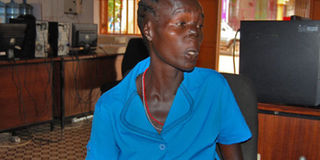LRA rebels cut off my lips, ears, nose and breast

Margaret Aciro
Ten years ago this month, the people of northern Ugandan who suffered during the gruesome war waged by Lords Resistance Army rebel leader Joseph Kony against the government of Uganda began to dream again as peace talks started in Juba, South Sudan.
A ceasefire was eventually agreed in August 2006, and Kony’s rebels, who had already fled into South Sudan, DR Congo and later the Central African Republic, did not return to haunt the people of northern Uganda. But this was after they had carried out devastating destruction, particularly abduction, maiming and murder.
Margaret Aciro, 32, had been escaping the atrocities of LRA for some time until her luck ran out one day in 2005 when the rebels kidnapped her as she headed to her farmland in Ali Village, Paicho Sub-county, Gulu District. She was seven months pregnant at the time.
“A tough (LRA) commander asked his juniors if any of them had a razor blade,” Aciro says. “They first refused but when he became tougher, one of them surrendered the razor blade and he was ordered to cut me.”
“The rebel cut off my ears, nose, breast and lips,” Aciro tells us at her stall in Gulu Main Market. Her story is one she seems so used to living with and telling that there is no visible sign of melancholy as she recounts it.
Better still, her face has since been reconstructed with help from World Vision. So she won’t cry as she tells her sad story because she probably recognises that she was in a way lucky.
Aciro, a mother of five, was abducted along with seven others.
“I am the only one who survived. All the people who were abducted with me were killed, including an eight-months old baby,” she says.
All the killings happened in her presence, after which she was taken to the rebel commanders who ordered the cutting of her body parts.
Another chance at life
Bleeding profusely and facing almost certain death, Aciro was abandoned and the rebels vanished. She would later be rescued by passersby, who alerted the government soldiers who eventually took her to hospital.
Aciro does not tell much regarding the treatment she had to undergo. All she remembers is the untold pain she suffered.
On recovery, it is perhaps true that the pain had made her stronger. She would take to life naturally and hustle even harder to improve her own situation and that of her family.
She grows millet, beans and maize to educate her children and cater to her other needs. The millet, in particular, is for sale.
When she is not tending to her gardens, Aciro sells hard and soft brooms, which she says are on high demand during school time.
She buys each broom at between Shs500 and Shs700, and sells it for a profit at Shs1,000. Sometimes the business is good, Aciro says, and her daily sales revenue goes to as high as Shs50,000. When the business is low her sales revenue can dwindle to Shs5,000.
Her stall in Gulu Main Market sets her back Shs6,000 a month. In the future, Aciro hopes to embark on rice growing in her attempt to fulfil her ultimate dream.
“I wish my children get the best education,” Aciro says. “They will be the ones to help me in the future since I am also challenged in doing hard work.”
Brief background
The LRA began as an evolution of ‘the Holy Spirit Movement’ - a rebellion against President Museveni’s government, led by Alice Lakwena. When Alice Lakwena was exiled, Joseph Kony took over, changing the name of the group to the Lord’s Resistance Army, or LRA.
As the group lost regional support, Kony quickly started a trend of self-preservation that would come to characterise the rebel group, stealing supplies and abducting children to fill his ranks.
The LRA terrorised northern Uganda for two decades when, in 2006, they indicated an interest in peace negotiations. These were hosted by South Sudan dubbed the Juba Peace Talks.
There is significant evidence that Kony ordered his fighters to attack villages and abduct children in the DR Congo during the peace talks.
Source: Invisible Children




